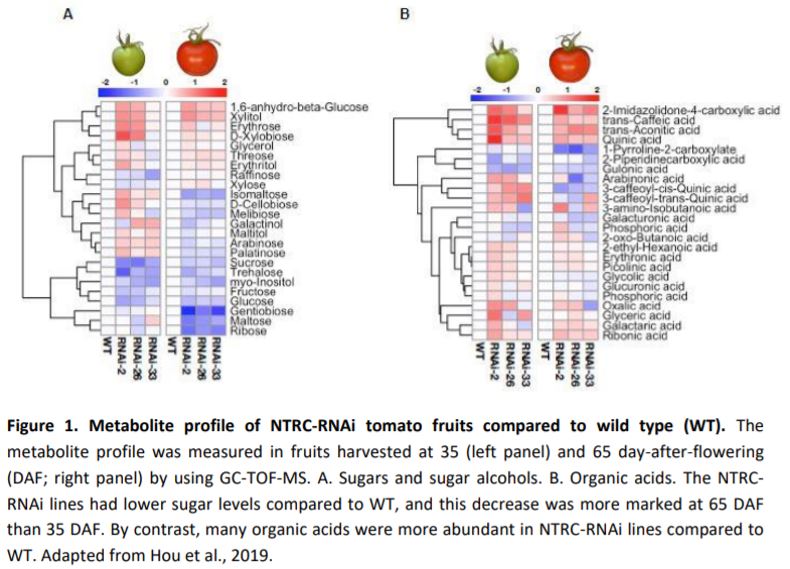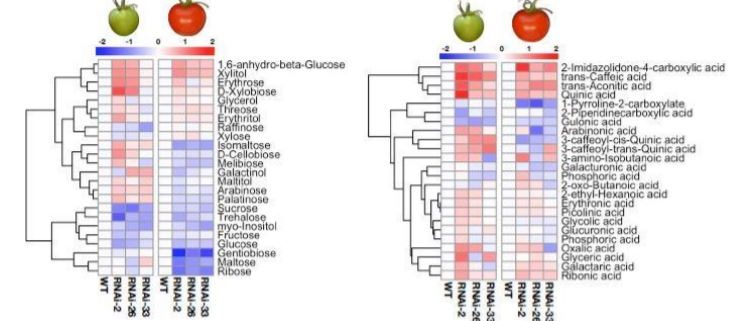NTRC: a key regulatory hub in carbon metabolism and redox balance in developing tomato fruits
Maria Grazia Annunziata
Max Planck Institute of Molecular Plant Physiology, 14476 Potsdam-Golm, Germany.
ORCID ID: 0000-0001-8593-1741
By acting as redox regulatory factor, NADPH-dependent thioredoxin reductase C (NTRC) is involved in many metabolic processes as well as plastid biogenesis. It is the only isoform, out of three, localized to chloroplasts. Arabidopsis thaliana NTRC has been extensively studied in photosynthetic tissues where it plays many important roles. It is involved in chlorophyll and starch synthesis, the Calvin-Benson-Bassham cycle, the abiotic oxidative stress response, non-photochemical quenching, and last but not least, the detoxification of reactive oxygen species (ROS), acting as an electron donor for 2-Cys-peroxiredoxin (Pérez-Ruiz et al., 2006; Kirchsteiger et al., 2009; Pérez-Ruiz et al., 2014; Thormählen et al., 2015; Da et al., 2017; Ojeda et al., 2017). Although the function of NTRC in chloroplasts has been studied for decades, it is only recently that NTRC has also been found to be present in non-photosynthetic plastids (Kirchsteiger et al., 2012). Little is known on the role of NTRC in heterotrophic plant tissues that lack photosynthetic functions and in crop plants.
 In this issue of Plant Physiology, Hou and colleagues shed light on the role of NTRC in developing tomato fruits using genetic and biochemical approaches (Hou et al., 2019). The authors generated NTRC-RNA interference (NTRC-RNAi) lines under the control of a fruit-specific promoter. With this approach NTRC expression was decreased by 50-75% in developing tomato fruits. The effects of the mutation were analysed in fruits harvested at 35 and 65 day-after-flowering (DAF). Perturbing NTRC expression did not affect the tomato fruit developmental and ripening programs, but caused reduced final fruit size and weight. In fact, fruit colour did not change in NTRC-RNAi lines compared to wild type (WT) at 35 and 65 DAF. Also, neither the chlorophyll content or the protein level of light-harvesting complex II (Lhcb2) significantly changed, and the expression levels of two genes involved in ethylene production and ripening did not significantly differ between WT and NTRC-RNAi lines.
In this issue of Plant Physiology, Hou and colleagues shed light on the role of NTRC in developing tomato fruits using genetic and biochemical approaches (Hou et al., 2019). The authors generated NTRC-RNA interference (NTRC-RNAi) lines under the control of a fruit-specific promoter. With this approach NTRC expression was decreased by 50-75% in developing tomato fruits. The effects of the mutation were analysed in fruits harvested at 35 and 65 day-after-flowering (DAF). Perturbing NTRC expression did not affect the tomato fruit developmental and ripening programs, but caused reduced final fruit size and weight. In fact, fruit colour did not change in NTRC-RNAi lines compared to wild type (WT) at 35 and 65 DAF. Also, neither the chlorophyll content or the protein level of light-harvesting complex II (Lhcb2) significantly changed, and the expression levels of two genes involved in ethylene production and ripening did not significantly differ between WT and NTRC-RNAi lines.
Metabolite profiling performed using gas chromatography-time-of-flight mass spectrometry (GC-TOF-MS) showed decreased levels of soluble sugars (Fig. 1A), while many organic acids (Fig. 1B), amino acids and phenolic compounds increased. Furthermore, in immature fruits NTRC down-regulation resulted in a 50-75% decrease in the level of the transient starch pool, which correlated with a decrease in the redox-activation of ADP-glucose pyrophosphorylase (AGPase) – a key regulatory enzyme in starch biosynthesis – and of its product ADP-glucose. Among the other starch metabolism enzymes analysed, only soluble starch synthase activity was strongly decreased.
Next the authors investigated whether NTRC was involved in controlling the cellular redox homeostasis in non-photosynthetic tissues like it does in photosynthetic plastids. Surprisingly, NTRC down-regulation caused a strong increase in the levels of the reduced forms NADPH and NADH, in mature as well immature fruits, indicating an essential role for NTRC. However, additional work is needed to discover the underlying mechanisms.
In conclusion, Hou and collaborators provide crucial insights on the central role of NTRC in carbon metabolism and redox balance in developing tomato fruits and indicate that NTRC activity is essential to improve fruit growth as well as quantity and quality of tomato yield.
REFERENCES
Da Q, Wang P, Wang M, Sun T, Jin H, Liu B, Wang J, Grimm B, Wang H-B (2017) Thioredoxin and NADPH-dependent thioredoxin reductase C regulation of tetrapyrrole biosynthesis. Plant Physiol 175: 652–666
Hou L-Y, Ehrlich M, Thormählen I, Lehmann M, Krahnert I, Obata T, Cejudo FJ, Fernie AR, Geigenberger P (2019) NADPH-dependent thioredoxin reductase C (NTRC) plays a crucial role in starch metabolism, redox balance and growth of developing tomato fruits and affects final fruit size and quality. Plant Physiol https://doi.org/10.1104/pp.19.00911
Kirchsteiger K, Ferrandez J, Pascual MB, Gonzalez M, Cejudo FJ (2012) NADPH thioredoxin reductase C is localized in plastids of photosynthetic and nonphotosynthetic tissues and is involved in lateral root formation in Arabidopsis. Plant Cell 24: 1534–1548
Kirchsteiger K, Pulido P, González M, Cejudo FJ (2009) NADPH thioredoxin reductase C controls the redox status of chloroplast 2-Cys peroxiredoxins in Arabidopsis thaliana. Mol Plant 2: 298–307
Ojeda V, Pérez-Ruiz JM, González M, Nájera VA, Sahrawy M, Serrato AJ, Geigenberger P, Cejudo FJ (2017) NADPH thioredoxin reductase C and thioredoxins act concertedly in seedling development. Plant Physiol 174: 1436–1448
Pérez-Ruiz JM, Guinea M, Puerto-Galán L, Cejudo FJ (2014) NADPH thioredoxin reductase C is involved in redox regulation of the Mg-chelatase I subunit in Arabidopsis thaliana chloroplasts. Mol Plant 7: 1252–1255
Pérez-Ruiz JM, Spínola MC, Kirchsteiger K, Moreno J, Sahrawy M, Cejudo FJ (2006) Rice NTRC is a high-efficiency redox system for chloroplast protection against oxidative damage. Plant Cell 18: 2356–2368
Thormählen I, Meitzel T, Groysman J, Öchsner AB, von Roepenack-Lahaye E, Naranjo B, Cejudo FJ, Geigenberger P (2015) Thioredoxin f1 and NADPH-dependent thioredoxin reductase C have overlapping functions in regulating photosynthetic metabolism and plant growth in response to varying light conditions. Plant Physiol 169: 1766–1786




